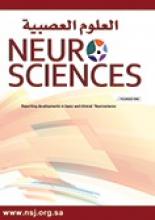Brief ReportBrief Communication
Open Access
Clinical and genetic features of anoctaminopathy in Saudi Arabia
Saeed Bohlega, Dorothy M. Monies, Ahmad A. Abulaban, Hatem N. Murad, Hindi N. Alhindi and Brian F. Meyer
Neurosciences Journal April 2015, 20 (2) 173-177; DOI: https://doi.org/10.17712/nsj.2015.2.20140547
Saeed Bohlega
From the Department of Neurosciences (Bohlega, Abulaban, Murad), Department of Genetics (Monies, Meyer), Department of Pathology (Alhindi), King Faisal Specialist Hospital and Research Centre, Riyadh, Kingdom of Saudi Arabia
MD, FRCPCDorothy M. Monies
From the Department of Neurosciences (Bohlega, Abulaban, Murad), Department of Genetics (Monies, Meyer), Department of Pathology (Alhindi), King Faisal Specialist Hospital and Research Centre, Riyadh, Kingdom of Saudi Arabia
PhDAhmad A. Abulaban
From the Department of Neurosciences (Bohlega, Abulaban, Murad), Department of Genetics (Monies, Meyer), Department of Pathology (Alhindi), King Faisal Specialist Hospital and Research Centre, Riyadh, Kingdom of Saudi Arabia
MBBS, SBNHatem N. Murad
From the Department of Neurosciences (Bohlega, Abulaban, Murad), Department of Genetics (Monies, Meyer), Department of Pathology (Alhindi), King Faisal Specialist Hospital and Research Centre, Riyadh, Kingdom of Saudi Arabia
MD, FAANHindi N. Alhindi
From the Department of Neurosciences (Bohlega, Abulaban, Murad), Department of Genetics (Monies, Meyer), Department of Pathology (Alhindi), King Faisal Specialist Hospital and Research Centre, Riyadh, Kingdom of Saudi Arabia
MD, FRCPCBrian F. Meyer
From the Department of Neurosciences (Bohlega, Abulaban, Murad), Department of Genetics (Monies, Meyer), Department of Pathology (Alhindi), King Faisal Specialist Hospital and Research Centre, Riyadh, Kingdom of Saudi Arabia
PhD
References
- ↵
- Duran C,
- Hartzell HC
- ↵
- Jarry J,
- Rioux MF,
- Bolduc V,
- Robitaille Y,
- Khoury V,
- Thiffault I,
- et al.
- ↵
- Bolduc V,
- Marlow G,
- Boycott KM,
- Saleki K,
- Inoue H,
- Kroon J,
- et al.
- ↵
- Penttilä S,
- Palmio J,
- Suominen T,
- Raheem O,
- Evilä A,
- Muelas Gomez N,
- et al.
- ↵
- Witting N,
- Duno M,
- Petri H,
- Krag T,
- Bundgaard H,
- Kober L,
- et al.
- ↵
- Hicks D,
- Sarkozy A,
- Muelas N,
- Koehler K,
- Huebner A,
- Hudson G,
- et al.
- ↵
- Van der Kooi AJ,
- Ten Dam L,
- Frankhuizen WS,
- Straathof CS,
- van Doorn PA,
- de Visser M,
- et al.
- ↵
- Magri F,
- Del Bo R,
- D’Angelo MG,
- Sciacco M,
- Gandossini S,
- Govoni A,
- et al.
- ↵
- Liewluck T,
- Winder TL,
- Dimberg EL,
- Crum BA,
- Heppelmann CJ,
- Wang Y,
- et al.
- ↵
- Sarkozy A,
- Hicks D,
- Hudson J,
- Laval SH,
- Barresi R,
- Hilton-Jones D,
- et al.
- Wahbi K,
- Béhin A,
- Bécane HM,
- Leturcq F,
- Cossée M,
- Laforêt P,
- et al.
- ↵
- Mahjneh I,
- Bashir R,
- Kiuru-Enari S,
- Linssen W,
- Lamminen A,
- Visser MD
- ↵
- Pénisson-Besnier I,
- Saint-André JP,
- Hicks D,
- Sarkozy A,
- Croué A,
- Hudson J,
- et al.
- ↵
- Lahoria R,
- Winder TL,
- Lui J,
- Al-Owain MA,
- Milone M
- ↵
- Milone M,
- Liewluck T,
- Winder TL,
- Pianosi PT
In this issue
Clinical and genetic features of anoctaminopathy in Saudi Arabia
Saeed Bohlega, Dorothy M. Monies, Ahmad A. Abulaban, Hatem N. Murad, Hindi N. Alhindi, Brian F. Meyer
Neurosciences Journal Apr 2015, 20 (2) 173-177; DOI: 10.17712/nsj.2015.2.20140547
Jump to section
Related Articles
- No related articles found.
Cited By...
- No citing articles found.





